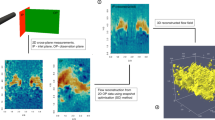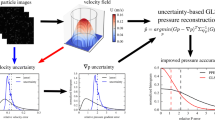Abstract
Measurement of the three-dimensional flow field inside the cardiac chambers has proven to be a challenging task. This is mainly due to the fact that generalized full-volume velocimetry techniques cannot be easily implemented to the heart chambers. In addition, the rapid pace of the events in the heart does not allow for accurate real-time flow measurements in 3D using imaging modalities such as magnetic resonance imaging, which neglects the transient variations of the flow due to averaging of the flow over multiple heartbeats. In order to overcome these current limitations, we introduce a multi-planar velocity reconstruction approach that can characterize 3D incompressible flows based on the reconstruction of 2D velocity fields. Here, two-dimensional, two-component velocity fields acquired on multiple perpendicular planes are reconstructed into a 3D velocity field through Kriging interpolation and by imposing the incompressibility constraint. Subsequently, the scattered experimental data are projected into a divergence-free vector field space using a fractional step approach. We validate the method in exemplary 3D flows, including the Hill’s spherical vortex and a numerically simulated flow downstream of a 3D orifice. During the process of validation, different signal-to-noise ratios are introduced to the flow field, and the method’s performance is assessed accordingly. The results show that as the signal-to-noise ratio decreases, the corrected velocity field significantly improves. The method is also applied to the experimental flow inside a mock model of the heart’s right ventricle. Taking advantage of the periodicity of the flow, multiple 2D velocity fields in multiple perpendicular planes at different locations of the mock model are measured while being phase-locked for the 3D reconstruction. The results suggest the metamorphosis of the original transvalvular vortex, which forms downstream of the inlet valve during the early filling phase of the right ventricular model, into a streamline single-leg vortex extending toward the outlet.
















Similar content being viewed by others
References
Adrian RJ (2005) Twenty years of particle image velocimetry. Exp Fluids 39(2):159–169
Afanasyev Y, Demirov E (2005) A variational filtration and interpolation technique for PIV employing fluid dynamical constraints. Exp Fluids 39(5):828–835
Asakawa D, Pappas G, Blemker S, Drace JE, Delp S et al (2003) Cine phase-contrast magnetic resonance imaging as a tool for quantification of skeletal muscle motion. In: Seminars in musculoskeletal radiology, THIEME, vol 7, pp 287–296
Barnhart DH, Adrian RJ, Papen GC (1994) Phase-conjugate holographic system for high-resolution particle-image velocimetry. Appl Opt 33(30):7159–7170
Cimino S, Pedrizzetti G, Tonti G, Canali E, Petronilli V, De Luca L, Iacoboni C, Agati L (2012) In vivo analysis of intraventricular fluid dynamics in healthy hearts. Eur J Mech B Fluids 35:40–46
Cressie N (1992) Statistics for spatial data. Terra Nova 4(5):613–617
Domenichini F (2011) Three-dimensional impulsive vortex formation from slender orifices. J Fluid Mech 666:506–520
Falahatpisheh A, Kheradvar A (2012) High-speed particle image velocimetry to assess cardiac fluid dynamics in vitro: from performance to validation. Eur J Mech B Fluids 35:2–8
Fredriksson AG, Zajac J, Eriksson J, Dyverfeldt P, Bolger AF, Ebbers T, Carlhäll CJ (2011) 4-D blood flow in the human right ventricle. Am J Physiol Heart Circ Physiol 301(6):H2344–H2350
Gunes H, Rist U (2007) Spatial resolution enhancement/smoothing of stereo-particle-image-velocimetry data using proper-orthogonal-decomposition-based and Kriging interpolation methods. Phys Fluids 19(064):101
Gunes H, Rist U (2008) On the use of kriging for enhanced data reconstruction in a separated transitional flat-plate boundary layer. Phys Fluids 20(104):109
Harlander U, Wright GB, Egbers C (2012) Reconstruction of the 3D flow field in a differentially heated rotating annulus by synchronized particle image velocimetry and infrared thermography measurements. In: 16th International symposium on applied laser techniques to fluid mechanics, Lisbon, Portugal
Hill MJM (1894) On a spherical vortex. Proc R Soc Lond 55(331–335):219–224
Hong GR, Pedrizzetti G, Tonti G, Li P, Wei Z, Kim JK, Baweja A, Liu S, Chung N, Houle H et al (2008) Characterization and quantification of vortex flow in the human left ventricle by contrast echocardiography using vector particle image velocimetry. JACC Cardiovasc Imaging 1(6):705–717
Jeong J, Hussain F (1995) On the identification of a vortex. J Fluid Mech 285(69):69–94
Kheradvar A, Gharib M (2009) On mitral valve dynamics and its connection to early diastolic flow. Ann Biomed Eng 37(1):1–13
Kheradvar A, Houle H, Pedrizzetti G, Tonti G, Belcik T, Ashraf M, Lindner JR, Gharib M, Sahn D (2010) Echocardiographic particle image velocimetry: a novel technique for quantification of left ventricular blood vorticity pattern. J Am Soc Echocardiogr 23(1):86–94
Kim H, Hertzberg J, Shandas R (2004) Development and validation of echo PIV. Exp Fluids 36(3):455–462
Kim J, Moin P (1985) Application of a fractional-step method to incompressible Navier–Stokes equations. J Comput Phys 59(2):308–323
Leonard A (1985) Computing three-dimensional incompressible flows with vortex elements. Annu Rev Fluid Mech 17(1):523–559
Liburdy JA, Young EF (1992) Processing of three-dimensional particle tracking velocimetry data. Opt Lasers Eng 17(3):209–227
Mangual J, Domenichini F, Pedrizzetti G (2012) Three dimensional numerical assessment of the right ventricular flow using 4D echocardiography boundary data. Eur J Mech B Fluids 35:25–30
Mullin JA, Dahm WJ (2005) Dual-plane stereo particle image velocimetry (DSPIV) for measuring velocity gradient fields at intermediate and small scales of turbulent flows. Exp Fluids 38(2):185–196
Mullin JA, Dahm WJ (2006) Dual-plane stereo particle image velocimetry measurements of velocity gradient tensor fields in turbulent shear flow. I. Accuracy assessments. Phys Fluids 18(035):101
Norbury J (1973) A family of steady vortex rings. J Fluid Mech 57(3):417–431
Novikov E (1983) Generalized dynamics of three-dimensional vortical singularities (vortons). Zh Eksp Teor Fiz 84:981
Núñez MA, Flores C, Juárez H (2006) A study of hydrodynamic mass-consistent models. J Comput Methods Sci Eng 6(5):365–385
Núñez MA, Flores C, Juárez H (2007) Interpolation of hydrodynamic velocity data with the continuity equation. J Comput Methods Sci Eng 7(1):21–42
Pereira F, Gharib M (2002) Defocusing digital particle image velocimetry and the three-dimensional characterization of two-phase flows. Meas Sci Technol 13(5):683
Poelma C, Mari J, Foin N, Tang MX, Krams R, Caro C, Weinberg P, Westerweel J (2011) 3D flow reconstruction using ultrasound piv. Exp fluids 50(4):777–785
Ratto C, Festa R, Romeo C, Frumento O, Galluzzi M (1994) Mass-consistent models for wind fields over complex terrain: the state of the art. Environ Softw 9(4):247–268
Sengupta PP, Pedrizzetti G, Kilner PJ, Kheradvar A, Ebbers T, Tonti G, Fraser AG, Narula J (2012) Emerging trends in CV flow visualization. JACC Cardiovasc Imaging 5(3):305–316
Stamatopoulos C, Mathioulakis D, Papaharilaou Y, Katsamouris A (2011) Experimental unsteady flow study in a patient-specific abdominal aortic aneurysm model. Exp fluids 50(6):1695–1709
Su LK, Dahm WJ (1996) Scalar imaging velocimetry measurements of the velocity gradient tensor field in turbulent flows. I. Assessment of errors. Phys Fluids 8:1869–1882
Sung J, Yoo J (2001) Three-dimensional phase averaging of time-resolved piv measurement data. Meas Sci Technol 12(6):655
Vedula P, Adrian R (2005) Optimal solenoidal interpolation of turbulent vector fields: application to PTV and super-resolution PIV. Exp Fluids 39(2):213–221
Westerdale J, Belohlavek M, McMahon EM, Jiamsripong P, Heys JJ, Milano M (2011) Flow velocity vector fields by ultrasound particle imaging velocimetry in vitro comparison with optical flow velocimetry. J Ultrasound Med 30(2):187–195
Willert C, Gharib M (1991) Digital particle image velocimetry. Exp Fluids 10(4):181–193
Zhang F, Lanning C, Mazzaro L, Barker AJ, Gates PE, Strain WD, Fulford J, Gosling OE, Shore AC, Bellenger NG et al (2011) In vitro and preliminary in vivo validation of echo particle image velocimetry in carotid vascular imaging. Ultrasound Med Biol 37(3):450–464
Zhong J (1995) Vector-valued multidimensional signal processing and analysis in the context of fluid flows. PhD thesis, University of Illinois, Chicago
Zhong JL, Weng JY, Huang TS (1991) Vector field interpolation in fluid flow. In: Digital Signal. Processing '91, Int'l. Conf. on DSP, Florence, Italy
Ziskin I, Adrian R, Prestridge K (2011) Volume segmentation tomographic particle image velocimetry. In: Proceedings of 9th international symposium on particle image velocimetry. Kobe University, Kobe, Japan, pp 21–23
Acknowledgments
This work has been supported by a Transatlantic Career Award from Fondation Leducq to Professor Arash Kheradvar. The authors are also grateful to Professor Federico Domenichini for providing his DNS data.
Author information
Authors and Affiliations
Corresponding author
Electronic supplementary material
Below is the link to the electronic supplementary material.
Supplementary material 1 (mp4 3837 KB)
Supplementary material 2 (mp4 3721 KB)
Rights and permissions
About this article
Cite this article
Falahatpisheh, A., Pedrizzetti, G. & Kheradvar, A. Three-dimensional reconstruction of cardiac flows based on multi-planar velocity fields. Exp Fluids 55, 1848 (2014). https://doi.org/10.1007/s00348-014-1848-8
Received:
Revised:
Accepted:
Published:
DOI: https://doi.org/10.1007/s00348-014-1848-8




